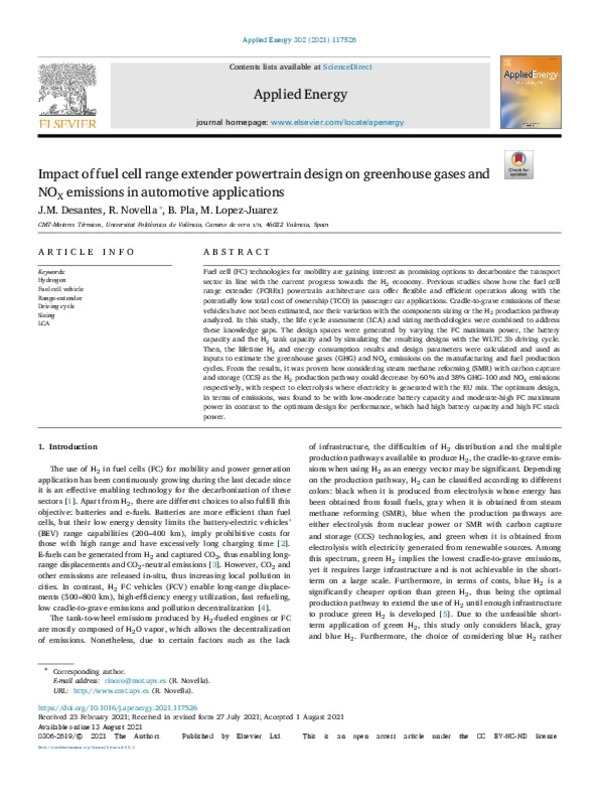JavaScript is disabled for your browser. Some features of this site may not work without it.
Buscar en RiuNet
Listar
Mi cuenta
Estadísticas
Ayuda RiuNet
Admin. UPV
Impact of fuel cell range extender powertrain design on greenhouse gases and NOX emissions in automotive applications
Mostrar el registro sencillo del ítem
Ficheros en el ítem
| dc.contributor.author | Desantes, J.M.
|
es_ES |
| dc.contributor.author | Novella Rosa, Ricardo
|
es_ES |
| dc.contributor.author | Pla Moreno, Benjamín
|
es_ES |
| dc.contributor.author | López-Juárez, Marcos
|
es_ES |
| dc.date.accessioned | 2022-05-13T18:05:41Z | |
| dc.date.available | 2022-05-13T18:05:41Z | |
| dc.date.issued | 2021-11-15 | es_ES |
| dc.identifier.issn | 0306-2619 | es_ES |
| dc.identifier.uri | http://hdl.handle.net/10251/182595 | |
| dc.description.abstract | [EN] Fuel cell (FC) technologies for mobility are gaining interest as promising options to decarbonize the transport sector in line with the current progress towards the H-2 economy. Previous studies show how the fuel cell range extender (FCREx) powertrain architecture can offer flexible and efficient operation along with the potentially low total cost of ownership (TCO) in passenger car applications. Cradle-to-grave emissions of these vehicles have not been estimated, nor their variation with the components sizing or the H-2 production pathway analyzed. In this study, the life cycle assessment (LCA) and sizing methodologies were combined to address these knowledge gaps. The design spaces were generated by varying the FC maximum power, the battery capacity and the H-2 tank capacity and by simulating the resulting designs with the WLTC 3b driving cycle. Then, the lifetime H-2 and energy consumption results and design parameters were calculated and used as inputs to estimate the greenhouse gases (GHG) and NOX emissions on the manufacturing and fuel production cycles. From the results, it was proven how considering steam methane reforming (SMR) with carbon capture and storage (CCS) as the H-2 production pathway could decrease by 60% and 38% GHG-100 and NOX emissions respectively, with respect to electrolysis where electricity is generated with the EU mix. The optimum design, in terms of emissions, was found to be with low-moderate battery capacity and moderate-high FC maximum power in contrast to the optimum design for performance, which had high battery capacity and high FC stack power. | es_ES |
| dc.description.sponsorship | This research has been partially funded by the Spanish Ministry of Science, Innovation and University through the University Fac-ulty Training (FPU) program (FPU19/00550) . Funding for open access charge: CRUE-Universitat Politecnica de Valencia | es_ES |
| dc.language | Inglés | es_ES |
| dc.publisher | Elsevier | es_ES |
| dc.relation.ispartof | Applied Energy | es_ES |
| dc.rights | Reconocimiento - No comercial - Sin obra derivada (by-nc-nd) | es_ES |
| dc.subject | Hydrogen | es_ES |
| dc.subject | Fuel cell vehicle | es_ES |
| dc.subject | Range-extender | es_ES |
| dc.subject | Driving cycle | es_ES |
| dc.subject | Sizing | es_ES |
| dc.subject | LCA | es_ES |
| dc.subject.classification | MAQUINAS Y MOTORES TERMICOS | es_ES |
| dc.title | Impact of fuel cell range extender powertrain design on greenhouse gases and NOX emissions in automotive applications | es_ES |
| dc.type | Artículo | es_ES |
| dc.identifier.doi | 10.1016/j.apenergy.2021.117526 | es_ES |
| dc.relation.projectID | info:eu-repo/grantAgreement/MICINN//FPU19%2F00550//AYUDA PREDOCTORAL FPU-LOPEZ JUAREZ. PROYECTO: ANALYSIS OF THE USE OF HYDROGEN IN POWERPLANTS FOR FUTURE TRANSPORT APPLICATIONS/ | es_ES |
| dc.rights.accessRights | Abierto | es_ES |
| dc.date.embargoEndDate | 2023-11-15 | es_ES |
| dc.contributor.affiliation | Universitat Politècnica de València. Departamento de Máquinas y Motores Térmicos - Departament de Màquines i Motors Tèrmics | es_ES |
| dc.description.bibliographicCitation | Desantes, J.; Novella Rosa, R.; Pla Moreno, B.; López-Juárez, M. (2021). Impact of fuel cell range extender powertrain design on greenhouse gases and NOX emissions in automotive applications. Applied Energy. 302:1-16. https://doi.org/10.1016/j.apenergy.2021.117526 | es_ES |
| dc.description.accrualMethod | S | es_ES |
| dc.relation.publisherversion | https://doi.org/10.1016/j.apenergy.2021.117526 | es_ES |
| dc.description.upvformatpinicio | 1 | es_ES |
| dc.description.upvformatpfin | 16 | es_ES |
| dc.type.version | info:eu-repo/semantics/publishedVersion | es_ES |
| dc.description.volume | 302 | es_ES |
| dc.relation.pasarela | S\445983 | es_ES |
| dc.contributor.funder | Ministerio de Ciencia, Innovación y Universidades | es_ES |
| dc.contributor.funder | Universitat Politècnica de València |








